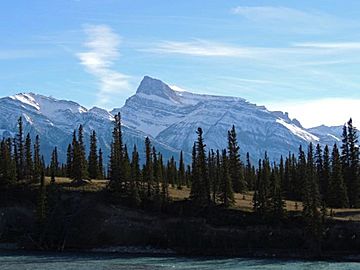Mount Peskett facts for kids
Quick facts for kids Mount Peskett |
|
|---|---|

Mount Peskett
|
|
| Highest point | |
| Elevation | 3,124 m (10,249 ft) |
| Prominence | 122 m (400 ft) |
| Parent peak | Mount Loudon (3221 m) |
| Listing | Mountains of Alberta |
| Geography | |
| Location | Alberta, Canada |
| Parent range | Murchison Group Canadian Rockies |
| Topo map | NTS 82N/16 |
| Type of rock | Sedimentary |
| Climbing | |
| First ascent | 1970 Leo Grillmair, W.L. Putman, D. Von Hennig |
| Easiest route | Scramble |
Mount Peskett is a tall mountain in Alberta, Canada. It stands 3,124-metre (10,249-foot) high. This impressive peak is located in the North Saskatchewan River valley.
It's part of the amazing Canadian Rockies. You can find it near the northern edge of the Siffleur Wilderness Area. Nearby, you'll find Mount Loudon and Siffleur Mountain. You can even spot Mount Peskett from Highway 11, also known as the David Thompson Highway. Rain and snow melting from the mountain flow into Loudon Creek and Spreading Creek. These creeks eventually join the North Saskatchewan River.
Mountain's History
This mountain got its name in 1968. It was named by Len Siemens. He chose the name to honor Reverend Louis W. Peskett. Reverend Peskett was a director for Youth for Christ. Sadly, he passed away in 1966 near Mount Cline due to a falling rock.
The name "Mount Peskett" became official in 1968. This happened when the Geographical Names Board of Canada approved it.
The first time anyone successfully climbed to the top was in 1970. The climbers were Leo Grillmair, W.L. Putman, and D. Von Hennig.
Understanding the Geology
Mount Peskett is made of sedimentary rock. This type of rock forms from layers of sand, mud, and tiny bits of plants and animals. These layers were laid down over millions of years.
The rocks formed during the Precambrian to Jurassic periods. Later, during an event called the Laramide orogeny, these rocks were pushed up. They moved east and even slid over younger rock layers.
Mountain Climate
Mount Peskett has a subarctic climate. This means it has very cold and snowy winters. The summers are usually mild.
Temperatures can drop below -20 °C (which is -4 °F). With the wind chill, it can feel even colder, sometimes below -30 °C (-22 °F).



